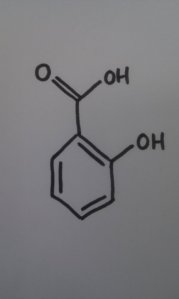I am charging through Book 4: The Right Chemistry, and after a shaky start, I'm enjoying it very much.
Last week I undertook an experiment to measure the acidity or otherwise of common household substances. It was just like being back at school, and I got to Make A Mess in the kitchen. Win!
I tested washing up liquid, shampoo, stain remover, laundry powder, tonic water, cranberry juice, bleach, tap water - and resisted the urge to plunder the house for anything that could have a Universal Indicator paper stuck into it. Including the cats.
I was very surprised at how acidic tonic water is - it has a pH of 3. So, what is pH?
pH stands for "potential hydrogen". I didn't know that, and don't remember being told at school (although it is entirely possible that I was setting fire to a bunsen burner at the time). This makes sense, however, as I now also know that the pH is a convenient way of describing what a substance's hydrogen ion concentration is.
So, tonic water has a pH of 3, which means that its hydrogen ion concentration is about 1.0 x 10¯³ mol dm¯³. Handy. Saves using lots of very small numbers and scientific notation.
Acids yield hydrogen ions when they are dissolved in water - so the higher the concentration of hydrogen ions, the more acidic the substance. Bases yield hydroxide ions: so the more hydroxide ions contained in a solution, the more basic that solution is.
The strength of an acid is determined by how far it dissociates in solution - hydrochloric acid, for example, is a strong acid because it dissociates almost completely. Almost all the HCl molecues dissociate to give positive hydrogen and negative chloride ions; whereas vinegar (acetic acid - or ethanoic acid, to give it its proper name) is a very weak acid as it only partially dissociates in solution.
The book then took us through the method of calculating a substance's pH from its hydrogen ion concentration - or vice versa. And very simple it is too. I can imagine it will come in very useful to you all on a daily basis - if for no other reason than to impress people in the pub.
"See that pint? It has a pH of 4.5, which means it has a hydrogen ion concentration of 0.0000316 mol dm¯³."
Anyway. I'm pleased with my progress, and have moved onto hydrocarbons. Which are pretty cool.
I am a long string of hydrocarbons. As are you. And so is almost everything, in fact. Including crude oil.
Hydrocarbons are subdivided into alkanes and aromatics. Alkanes are further subdivided into linear-chain alkanes, branched-chain alkanes, and cycloalkanes. This are all pretty good descriptions of their molecular structures.
Carbon has a valency of four, meaning that it can hang onto four other atoms. Hydrogen has a valency of one, so it can only hang onto one other atom. Linear-chain alkanes are long strings of carbon atoms attached to a maximum of two other carbon atoms, and two or three hydrogen atoms. These alkanes can also be folded over; they needn't be long, straight strings.
Branched-chain alkanes are similar to linear-chain alkanes, but instead of having two hydrogens, a carbon atom will be attached to a third carbon, forming a "branch". Hence the name.
And cycloalkanes are rings of carbon atoms, with hydrogen atoms attached. These, too, can have branches.
Aromatics are also rings of carbon atoms, but some of them have double bonds, and some of them single bonds.
All this is useful for grading petrol, believe it or not. When you're filling up your vehicle, the unleaded nozzles have "95" or "97" printed on them. These are the octane numbers; and the higher the octane number, the better the performance of the petrol. Y'see, linear-chain alkanes don't make very good motor fuel - they burn unevenly, and cause the engine to "knock" (small explosions interrupting the burn). Branched-chain and cycloalkanes are much better; and if you can add an aromatic to the mix, then it's better still.
I'm not sure why yet; I'll get back to you when I've found out.
I'm particularly enjoying hydrocarbons as I get to draw molecular structures. This pleases me: they are very regular, and appeal to my sense of neatness. This is ethane:

And this is an aromatic - napthalene - note the double bonds, and pleasant circular structure:
 I've downloaded a chemistry drawing package to use for my Tutor Marked Assignment. I'll see how I get on with that...
I've downloaded a chemistry drawing package to use for my Tutor Marked Assignment. I'll see how I get on with that...
I'm looking forward to Book 5: Life - and am hoping it will give me more of an idea of my future studying direction. I love everything so far - but I think a focused four-directional future will be time-consuming to say the least...





